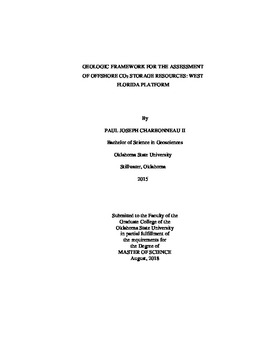| dc.contributor.advisor | Pashin, Jack C. | |
| dc.contributor.author | Charbonneau, Paul Joseph, II | |
| dc.date.accessioned | 2019-07-19T14:08:49Z | |
| dc.date.available | 2019-07-19T14:08:49Z | |
| dc.date.issued | 2018-08-01 | |
| dc.identifier.uri | https://hdl.handle.net/11244/320971 | |
| dc.description.abstract | The West Florida Platform is a broad continental shelf west of peninsular Florida. The platform contains abundant sinks and seals that appear favorable for future commercial storage of CO2. Proven offshore storage technologies, like those that have been deployed in the North Sea, are likely transferrable to the West Florida Platform. This thesis is part of a larger study to evaluate the CO2 storage potential of the Eastern Gulf of Mexico continental shelf adjacent to Mississippi, Alabama, and Florida. This project involves a detailed analysis of data from eight exploratory wells in the area of the Sarasota Arch, and includes analysis of geophysical logs, interpretation of 2D reflection seismic profiles, and volumetric analysis of the CO2 storage resource. | |
| dc.description.abstract | The Sarasota Arch is the primary controlling structure associated with reservoir development. Porous dolomite is concentrated in this structure, and the dolomite passes into nonporous limestone in the flanks. The porous strata identified in the Sarasota Arch have a potential storage resource of more than 878 Gt of CO2. Limestone and dolomite in Cretaceous and Paleogene strata are the primary targets for CO2 storage. The Lower Cretaceous Punta Gorda, Gordon Pass, and Panther Camp assessment units appear suitable for injection and storage of supercritical CO2 and contain abundant stacked dolomitic reservoirs, which are separated by regionally continuous anhydrite confining units. Reservoirs assessed in the Upper Cretaceous and Lower Paleogene Cedar Keys assessment unit contain a potential storage resource of approximately 600 Gt of CO2, however the lateral extent of the confining anhydrite beds is not as great as in the older units. Storage potential and sealing potential are greatest in Lower Cretaceous strata, which can hold a potential storage resource of about 278 Gt. Multi-gigatonne storage potential on the West Florida Platform could provide a viable storage option in the Eastern Gulf of Mexico, and consequently reduce the emissions footprint in the south-eastern United States. | |
| dc.format | application/pdf | |
| dc.language | en_US | |
| dc.rights | Copyright is held by the author who has granted the Oklahoma State University Library the non-exclusive right to share this material in its institutional repository. Contact Digital Library Services at lib-dls@okstate.edu or 405-744-9161 for the permission policy on the use, reproduction or distribution of this material. | |
| dc.title | Geologic Framework for the Assessment of Offshore CO2 Storage Resources: West Florida Platform | |
| dc.contributor.committeeMember | Puckette, James O. | |
| dc.contributor.committeeMember | Ismail, Ahmed Mahmoud Ali | |
| osu.filename | CharbonneauII_okstate_0664M_15941.pdf | |
| osu.accesstype | Open Access | |
| dc.description.department | Geology | |
| dc.type.genre | Thesis | |
| dc.type.material | Text | |
